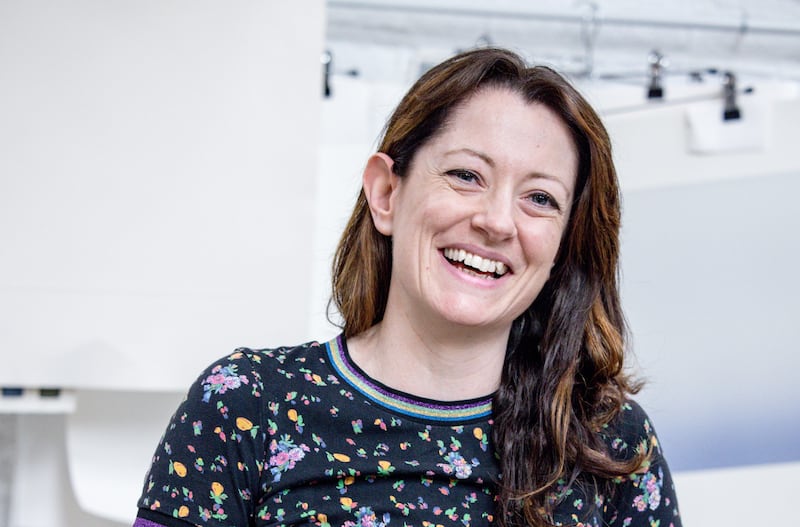Leah Foley had returned from a year in Canada, and was emerging from a significant break-up, when she decided it was time to “revamp” her life. A second-level music teacher by training, the Co Clare woman found work in administration after graduating from college during the pandemic.
Teaching jobs “didn’t exist then”, she recalls. After several years in admin, she went to Canada. “And then I came home to Lahinch and fell back in love with the place. My training was for post-primary but I always loved working with younger kids so I decided to do a master’s in primary teaching.”
To become a primary teacher, Foley needed to re-sit her Leaving Cert Irish exam. She spent nine months studying the language before taking the exam in June. However, before all this, and following the advice of her grandmother, she spent a week at the Coláiste na Rinne adult Irish language course in Co Waterford.
“That week I spent in Ring was a massive turn around for me – the people I met, the culture I dived into – six weeks after a significant break-up, it was the best thing I could have done. It also reignited an interest in education, something I didn’t realise I was missing.
RM Block
“Five years ago I had no interest in speaking Irish but this has sparked a new passion. I think everyone should experience the Gaeltacht and its people – their outlook on the Irish language is so different from ours, it’s a really beautiful thing to witness.”
Foley is one of the growing number of Irish adults choosing, for personal and professional reasons, to spend time in a Gaeltacht region and improve their native language skills. Some 13 providers currently offer adult courses across Gaeltacht areas, ranging from Acadamh na hOllscolaíochta Gaeilge in Co Galway to Coláiste Uisce in Co Mayo and Oidhreacht Chorca Dhuibhne in Co Kerry.
Rónán Ó Dochartaigh, manager of the Oideas Gael adult Irish language and cultural courses in southwest Donegal, says student numbers are increasing year on year, notwithstanding the break in classes during the pandemic. In 2024, Oideas Gael welcomed 2,200 students during its summer, Easter and bank holiday weekend courses, accounting for 15,000 bed nights in the Gleann Cholm Cille and Gleann Fhinnne Gaeltacht areas.

Students are aged between 18 and 88, with courses ranging from beginner to advanced levels for fluent speakers. Some 60-65 per cent of students are Irish, while the remainder come from across Europe and North America, with recent attendees travelling from New Zealand, Argentina and Paraguay, says Ó Dochartaigh. Their presence in the Donegal Gaeltacht makes a “two-way contribution”, he says. “We want to help people learn the language but they’re helping us as well. People always focus on the economic, and that’s great, but more importantly it strengthens the language. The Irish language has survived here but it’s still under pressure and people coming here creates a strong incentive to speak Irish.”
“There has been a lot of talk of an explosion of interest in Irish in recent years because of popular culture but I think it’s been a long time coming. There’s been a general shift in attitudes and then you have the changes in recent decades like Raidió na Gaeltachta, TG4 and the Cailín Ciúin effect, with Irish language projects succeeding on the world stage. I think Covid also changed people’s relationship to this country. A lot of the baggage has been removed.”
Ian Mac Gabhann, adult language education officer with Gael Linn, says numbers attending the organisation’s adult courses in Gaoth Dobhair, Co Donegal, are also increasing. He believes people have “eventually got over the hurdle of people solely seeing Irish as a school subject”. “I didn’t like Irish in school, I wasn’t great at it and now I work fully through Irish. I think with the increase in different nationalities in our country, we hear other languages and ask ourselves, ‘why don’t I understand my own language’.”
“There’s more respect for the language and a healthier mindset towards it,” says Mac Gabhann. “The question ‘an bhfuil Gaeilge agat’ no longer means ‘are you fluent in Irish’. It just means, do you have some Irish.”
@theirishtimesnews For many, the ritual of heading to the Gaeltacht as a teenager holds fond memories of craic, ceol and céilí – even if the actual Irish classes weren’t overly exciting. But did you know there are Gaeltacht courses for adults? Irish Times journalist Rebecca Daly recently went to an adult Gaeltacht to brush up on her cúpla focal. Click the link in our bio to read how she got on #gaeltok #gaeltacht #irish #ireland #gaeilge #donegal #irishlanguage #kneecap
♬ original sound - The Irish Times
Visual artist Clare Henderson, who spent a week in the Waterford Gaeltacht last year, decided to spend €980 on the course (which covers classes, accommodation and full board) because she felt the “loss” of not speaking her native language. “I don’t want to use the word shame but it’s really sad as a postcolonial country we don’t have our own fluent national language. As I get older, I realise how deep that goes, how much was taken away from us.
“I have friends who speak fluent Irish and it’s beautiful and impressive, it motivates me to learn more. I think historically there was this idea Irish culture was passé but that’s changing. And this isn’t just because Kneecap are cool, Kneecap are part of that timeline of change.”
[ Kneecap’s use of Irish is perfectly in tune with Eoin MacNeill’s visionOpens in new window ]
While Henderson loved the Irish classes in Waterford, she was disappointed with the cultural activities offered in the afternoon. “They were bad because they were in English and for me that was a massive loss of learning. I’m not a child and I’m not sad about speaking English with my friends. We had the best craic but I wanted to be a bit more immersed.”

Barbara, who requested only her first name be used, disagrees that total immersion is necessary to improve Irish language skills. “If you’re an adult and you want to learn you’ll take the steps to do so.” Having decided to return to college in her 40s to become a primary schoolteacher, Barbara had to spend two fortnight stints in a Gaeltacht region over two summers. Her first experience in Ráth Chairn, Co Meath, was “awful” she says. Accommodation and food standards were low and teaching was “haphazard”. “We were paying a lot of money to do this on top of our college fees, and those of us with children had to organise two weeks of childcare. It’s a back-breaking commitment.”
Her second course the following year in the Connemara Gaeltacht region of Carna was much more positive, she says. “It was still strict, they took roll call three times a day, but you felt like you were attending proper Irish lectures and the accommodation was immeasurably better.”
Barbara has “mixed feelings” about the requirement for primary schoolteachers to spend time in the Gaeltacht. “I think the cultural element is lovely and I did improve my Irish but I’d probably have learned just as much doing lectures Monday to Friday out in UCD. I know the Gaeltacht areas need more of a spotlight and I’m very interested in preserving the language but it felt a bit like an exercise in propping up the Gaeltacht.”
Research carried out last year by Gaelchultúr, in collaboration with Údarás na Gaeltachta, found two-thirds of Irish people regretted not speaking better Irish, while three quarters agreed the language is essential to the identity of Irish people. Some 64 per cent of respondents in the Amárach Research survey of 1,000 people said the Government needs to do more to support Gaeltacht communities.
A spokesman for the Department of Rural and Community Development and the Gaeltacht said the Government remained committed to the successful implementation of the official languages act and the normalisation of the Irish language as part of the provision of public services in this country. The act includes a provision that 20 per cent of new public service recruits be proficient Irish speakers by the end of 2030. Since 2021, the number of civil servants taking Government-provided Irish language courses has increased by 140 per cent.
While the Government does not financially support Gaeltacht courses for adults, it continues to subsidise courses for second-level students and third-level undergraduate trainee teachers, he said. Last year, 27,000 students attended these Irish college courses, exceeding pre-Covid numbers.
Pádraig Mac Brádaigh, vice-president for Gaeilge at Aontas na Mac Léinn in Éirinn (formerly the Union of Students in Ireland) believes Gaeltacht immersion is the only way to fully appreciate the depth of the Irish language. “The type of Irish you learn in a Gaeltacht course is so much richer, it gives you that ‘saibhreas teanga’ (richness of language). There’s a lot of ways to express yourself that you’re not really taught in a classroom and you develop a much deeper connection with the language.”

Mac Brádaigh attended Gaeltacht courses in the Connemara village of an Cheathrú Rua in recent years during his Irish language degree at Trinity College. Attendees on the courses included undergraduate students training to be primary schoolteachers, he says. He claims some of “these students didn’t even try to speak Irish, they actually made fun of us Trinity students for speaking Irish. These are the people who will be teaching hundreds of children this language and they didn’t care. It was shameful.”
Unlike every other student on his Gaeltacht course, Mac Brádaigh did not learn Irish at school. The grandson of Irish emigrants from Co Cavan, he was born and brought up in New York. “I grew up with friends in New York who spoke loads of different languages and they told me I was a basic white person with no culture. And as blunt as that may sound, they were correct. That’s why I had to learn my language. And as soon as I started learning, I felt it was a huge part of me that was missing.”
[ An Cailín Ciúin study guide launched to help with Irish language educationOpens in new window ]
Mac Bradaigh, who passed A-level Irish and the TEG (Irish language proficiency exam) before studying Irish at Trinity, became the university’s first full-time student union Irish language officer. He agrees there is a general change in mindset towards the language but is concerned the interest could be short lived.
“Irish has become trendy but action needs to follow. If you look at the last census the number of people speaking Irish every day is falling. Any person with a newfound passion for Irish should be praised but also encouraged to scratch below the surface and look at the real state of the language. The trendiness of Irish means nothing unless we do something about it.”






















